|
Shunya Bhajana Pitha, Banki Muhana, Gandharva Math, Puri
Places related to Shri Achyuta:
-
Shunya Bhajan Pitha, Puri •
Padma Vana Pitha, Nemāla •
Achyutananda Yogashram (Pothi Ashram), Kākatpur •
Avdhoot Ashram of Sri Artatrana Das, Konark •
Tattva Bata, Jobra Ghat, Cuttack •
Udaya Bata and Ratna Bata, Paradip •
Olasuni Gumpha of Arakhita Das, Olasuni •
Chhatiā Bata of Sri Hadi Das, Jajpur •
Khandagiri and Udayagiri caves, Bhubaneswar •
Gadaa Khsetra of Devi Biraja (Durga), Jajpur •
Mahapurusha Achyutananda Das, Shunya Bhajana Pitha, Banki Muhana, Puri, Odisha, India
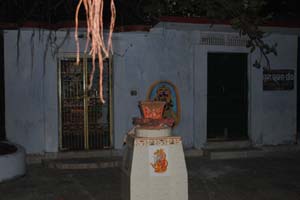
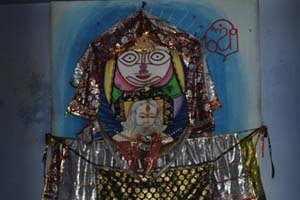
ମହାପୁରୁଷ ଅଚ୍ୟୁତାନନ୍ଦ ଦାସଂକ ଶୂନ୍ୟ ଭଜନ ପୀଠ, ବାଂକି ମୁହାଣ, ପୁରୀ, ଓଡିଶା, ଭାରତ
Banki Muhana, Shunya Bhajana Pitha, Gandharva Matha
|
Puri, a small coastal town in the state of Odisha, needs no introduction and is quite popular in itself as the abode to Lord Jagannath. It is one of the four prime pilgrimages in India (Char Dham) and also is a popular tourist destination because of its excellent sea beach and other interesting sites around the town of Puri. It is an ancient place whose reference has been made in several Puranas, even though the modern day temple dates back only to the 12th century!. According to the legend, the temple that is visible today was built atop ruins of a very old temple, referring back to King Indradyumna in Satya Yuga.
The purpose of this article, however, is to shed some light on the relation between Achyutananda (and PanchaSakha) and Puri, and specifically on the Shunya Bhajana Pitha of Shri Achyutananda Das. All of the five Sakhas, being devotees of Shri Jagannath, were related to Puri. They had established their seats in different places, however, spent a significant part of their lives in Jagannath Dham, Puri.
|
Mahapursha Achyutananda was born by the will of Lord Jagannath and Shri Chaitanya and is one of the Lord's eternal associates being his expansion only. For the divine sport, Lord's eternal associates take birth in every era. Mahapurusha Achyutananda is none other than an expansion of the PurnaBrahma Lord Jagannath, who created Achyuta from his own Kalā being pleased by the devotion of Dinabandhu Khuntia and Padmavati (father and mother, respectively). Achyuta spent his childhood days near his birth place Tilakanā (close to PadmaVana Nemala that later became his Samadhi Pitha). However, he used to frequent to Puri with his father, who was a great devotee of Lord Jagannath. His childhood name was Agaṅi (ଅଗଣି) and he used to spend his days very unattached because of past samskaras of devotion, as if he was longing for someone. His parents also began to worry looking at his ways. It was not until Agaṅi met Shri Chaitanya at Puri BadaDānda that he regained all his memories and spiritual powers. At Puri, after meeting Chaitanya, Agaṅi recognized himself who he was and accepted Shri Chaitany as his Guru. Later, in Shunya Samhita, he describes his meeting with Shri Chaitanya to his disciple Ram Das (past life of Baba Buddhanath Das) as follows:
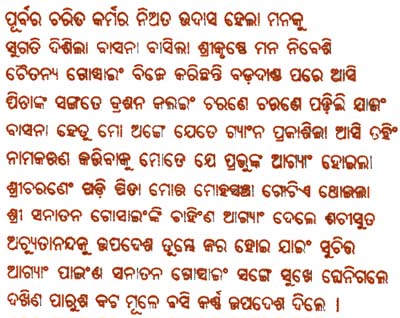
|
By virtues of the past deeds, I lost interest in the mundane
My heart called for the Path and in thoughts Shri Krushna remained
We heard that Lord Chaitanya has come to Puri Grand Trunk Road
With my father, I went for a Darshan and at his feet I fell
Based on my past merits, all divine knowledge came back in a flash
Lord Chaitanya instructed then after for my initiation
At his feet, my father also offered oblation
Looking at Sanatan Goswami, the Son of Sachi (Chaitanya) said:
"Take Achyutananda along, initiate and advice on spiritual matter
After receiving the order, happily Sanatan Goswami took me along
Sitting near the South Banyan tree, he whishpered Mantra in my ears...
|
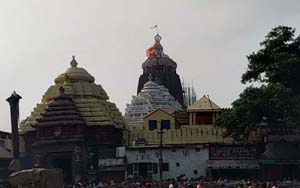
view of Shri Jagannath Temple - a typical day
|
There has been some recent works where people attempt to prove that PanchaSakha's path was different than that of Chaitanya's and inadvertently tried to establish that there were differences between PanchSakha and Chaitanya. The outward practices might have been different and part of it is the Kali Yuga Lila (divine sport). However, Achyuta, in his own writings, acknowledges Shri Chaitanya to be a partial manifest of Shri Vishnu and addresses him as "My Lord and My Guru". Even Chaitanya also held PanchSakha in high regard and said that these 5 saints are my 5 souls and are no lesser than Vishnu. Also, Baba Buddhanath Das has referred to Chaitanya multiple times as: "Lord came and preached his own name and disappeared back to where he came from. The same formless Brahma had manifested partially in the form of Chaitanya and disappeared into the self". Thus there were no differences between these great souls and they all have complementary roles to each other...
|
After the initiation at Puri, Shri Achyutananda went back to Tilakana but after the demise of his parents came back to Puri for a longer stay. For a long time, he guarded the secrets of his true identity and fathomless knowledge and spiritual powers, the same way he chose to remain anonymous during one his prevous births as Sudama. Historical records show that in the early part of his life, he would write against any social atrocities, including any wrong doings by Brahmins or even the King. The initial writing style was "samalochana mulak" (had elements of criticism to it). After writing, however, he did not bother enough to preserve them and just let them loose and be lost. It was during such times that Shri Achyuta went through some tests by the King and some Pundits, which were only a part of the divine sport. One such test was called the Shunya Bhajana (ଶୂନ୍ୟ ଭଜନ), near the old Banki Muhana (estuary). Note that, the present day Banki Muhana is different than that in the 15CE because of the shift of the coastal boundary. The "Shunya Bhajana Episode at Banki Muhana" is described next.
|
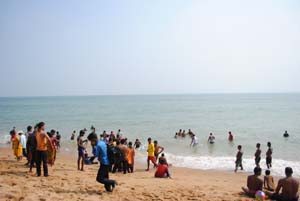
Puri Sea Beach - a typical day
|
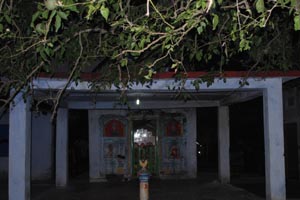
Temple atop Bamphi (well) burried underneath
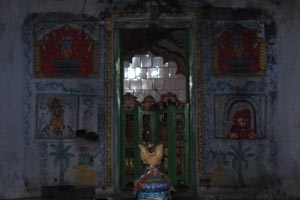
The deities at Shunya Bhajan Pitha
|
During his stay in Puri, Shri Achyuta was once asked by the King (Prataprudra Dev) about his spiritual practices and demanded a demonstration, instigated by some Brahmins. Sri Achyuta, upon hearing the questions, concentrated on The Shunya and answered: "My Mantra is Nirakar and my Bhajan is Shunya". This answer, although attractive, was not very convincing to the Brahmins and the King. Therefore, the king demanded that Shri Achyuta give a live demonstration of Shunya Bhajan. Consumed by the desire to see a live demonstration, the king almost forgot to ask for the Mantra and it remained secret. The outward manifestaion of Shunya Bhajan involves the Yogi suspending slowly in air and then immersing his conscious in the Shunya completely, which is what the king got interested in witnessing. Hearning such a bizzare claim, the King and Brahmins took Achyutananda to Banki Muhana, where a well was dug. They then demanded that Achyuta shows what he says.
Shri Achyuta, taking surrender at Lord's feet, made a demonstration of Shunya Bhajan, suspending in the air on top of the well; this well was named as Shunya Bamphi (ଶୂନ୍ୟ ବାମ୍ଫୀ) and the place is called "Shunya Bhajana Pitha".
The images to the left are of a small temple where Jagannath, Balabhadra, Subhadra are the presiding deities. Legend says that the well (Shunya Bamphi) is burried beneath this small temple, where Shri Achyuta had made this remarkable demonstration in a time when the kings had a lot of ruling power. After the demonstration, the king accepted Shri Achyuta as a realized saint and granted him this place at Banki Muhana that henceforth was known as Achyuta's Shunya Bhajana Pitha. There is also a Matha (monastery) nearby, called as Gandharva Matha. Till date, Rāhāsa Kirtan is annually observed in this Matha in the name of Mahapurusha Achyutananda Das (see image below).
|

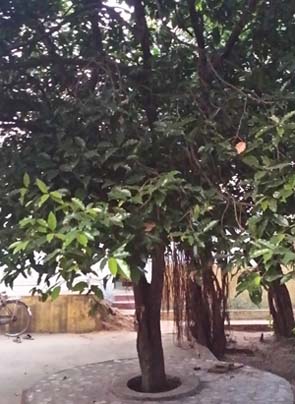
Invitation from Gandharva Matha to attend Nitya Rāsa Celebration between 2-6 November, 2014. Rāhāsa Kirtan refers to a form of mass-chanting in outdoors and is very dear to Shri Achyuta. At Gandharva Matha, Puri and other places related to Shri Achyuta, till date, Rahasa Kirtana is observed every year. The left image above is an invitation from Gandharva Matha to attend such a celebration in the year 2014. A banyan tree is present (above, right), as in most places related to Shri Achyuta.
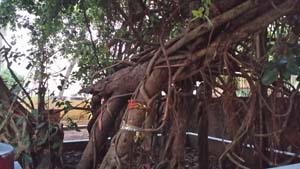
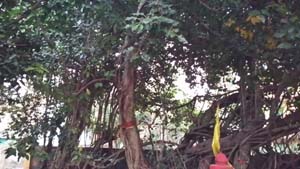
Bata Brukhya (Banyan Tree), Shunya Bhajana Pitha, Banki Muhana, Puri, Odisha
This was the history behind Shunya Bhajana Pitha. Now, a question will arise, in the minds of our readers, as to "what is Shunya Bhajana?". This is very difficult to answer, unless one is a Shunya Sadhak but the compassionate Achyuta has written some description about it in Shunya Samhita, including the details of the circumstances where he made this demonstration. Below we quote the chapter of 'Shunya Bhajana' from 'Shunya Samhita', along with an English transliteration. We hope that our readers will benefit out of it, from both spiritual or literature perspective. Happy reading:

|
“Listen Ramachandra, Braja’s son. I shall disclose a secret Bhajana to you.
When one truly assimilates the essence of this Bhajana, this Bhajan is capable of imparting all-round success. It can bestow Chatur-varga (Dharma, Artha, Kaama, Mokhsha) and destroys grave dangers. At the end of the life-span, even Kāla (the God of death, Yama) cannot torture the mortal. It destroys all imminent hurdles just by a moment of its recollection. One can achieve Ashta Yoga Siddhi (the eight major yogic powers: Aṇimā, Mahimā, Garimā, Laghimā, Prāpti, Prākamya, Iṡittā, Vasitva) by this. This Bhajana needs no formal requirements of Kaya Suddhi, Asana Suddhi, Anganyasa (yogic cleansing of body, seat and enlivening of body parts) etc or restrictions on food and living. When a Sādhak thinks it even for a while each day and night, his or her life becomes purposeful and such Sādhaks are regarded as one in a crore.
O boy, Rama Dasa, listen to its extraordinary impact by which one accomplishes rare Chaturvarga. He, who has the privilege to drink nectar cares little about ghee, milk and cream or sugar juice. Although sugar-cane juice is very sweet when it is properly prepared, yet it counts little. When one is in possession of pure iron rod, he may find it valuable. However, when one gets to possess Brass, he or she drops the iron. Similarly, if one has to choose between Silver and Brass, one will go for Silver. Likewise, one opts Gold over Silver. When you have gold, you have access to every other thing. There is no need of possessing other materials. So, you must judge carefully in your mind by the touch stone of your conscience, as to what is Gold (metaphoric). Wherever your mind settles in, ascertain it properly. It must ultimately lead to Nirvāna. Then your preserve and stick to that wealth. Such is this Bhajana and know that it is a bestower of the Chaturvarga. The eight Siddhis, including Aṇimā, are all contained in this Bhajana. One obtains it by past merits and only a true and noble preceptor knows this. Therefore, you immerse yourself on Dvatrimsa-Akhsara (32 syllables).”
At this Rama Dasa was delighted. Then, Shri Achyuta continues narrating an incident of demonstration of Shunya Bhajan:
“Once the king Prataprudra Deva took me to task in the temple (of Shri Jagannatha). He ordered, ‘O’ Dasa, answer me, from which mantra, Bhajana mantra has originated? What is the meaning of 24-syllabled Gayatri mantra, and what are the Anāma Nama and Kāma vijas (seeds)? What is your mantra? You must give the true answer.”
The Brahmins also taunted at me and because of their jeering the king became increasingly obstinate. There were a few Brahmins who were well versed in different mantras and some of them knew the principles of Brahma Jnana mantra. All of them had some differences with me and unanimously cried out, ‘Achyuta Dasa, give your reply immediately.’ The king insisted, ‘You Dasa, let us test your knowledge.’
I was put in a difficult situatin, indeed. I asked repeatedly to my mind and conscience. Then I concentrated my mind on the lotus feet and had a taste of the nectar (this is in reference to Kundalini Jagaran by Layanga Yoga and is not explained here for the sake of brevity). The Lord, an ocean of bliss, came to save me. He impelled me to refer to "Shunya Bhajana". Then it became visible to me and I concentrated on the 32-syllabled mantra. I put Nāma; beneath Anāma and wrote down Kāma Vija and then Om under it. I kept the Panchavargavara. I placed this as a Yantra.”
Looking at this, the Brahamins were surprised. They exclaimed, ‘Dear Dasa, you know the Tattva (gist). This Dasa at times speaks of Tattva and his knowledge of Tattva is very secret. Now you have placed before us a secret Yantra. Kindly explain it to us, how you have come to know about Nāma, Anāma and Kāma Vija along with Omkara, given in this particular combination. Never have we heard of this in Purānas. Dear Dasa, where from have you learned it and what Bhajana is it called? Please tell us all about this’.
They kept insisting on it and brought it to the notice of the king again. The king further requested me to explain it. At this, I was again put to a new situtaion. However, I spoke out, ‘Listen, O King: The mantra is Nirakara Mantra and the bhajana is Shunya Bhajana. It needs no Asana-shuddhi, Anga-nyasa, Sthana-shuddhi and Diga-bandha. For this Bhajana, one sits upon Shunya (gradually lifts the body and stays suspened in air) till you go beyond time (Kāla) and in due course, you will attain Goloka. This is the Bhajana and there nothing beyond this anywhere- This Is The Ultimate.
Listening to this, the Brahims remained unconvinced. They again instigated the king to ask me for a demonstration of this Bhajana. One of the Brahamins, mocking at me, suggested, “Let us take Dāsa to a deep well and let him have his Shunya Bhajana there.” While he spoke, there was enough confusion. The king too was influenced by the Brahmins' insistence to a demonstration of my words. There was a lot of noise due to the debate. Instead of asking me about the Mantra, the king also got distracted on the demonstration aspect. It was by the will of the Lord not to divulge the mantra aspect of my yantra of bhajana. Though my mind was perturbed, I fully understood that the Lord desired to keep the mantra secret to all of them. If the king would have insisted on mantra, I would have been at some risk. Lord is Aratabhanjana (one who dispels troubles). He deliberately created such confusion in which nearly three hours passed. The king then took me to the Bada Danda (Main Road) and there was a huge crowd. There from, he took me to Banki Muhani (a place on the then outskirts of Puri) where a Bamphi (well) was dug out. He commanded me to demonstrate Shunya Bhajana on the space above the well, before the witness of the Brahmins. Hearing this, I was beseized by fear but immediately concentrated on Ananta Murti. I mused upon the 32 syllables and sat on my navel. I looked upward and gradually merged myself in Nirakara rupa. I pushed up my Prāna and placed it on Shunya. Then I focused my attention on Parama Hamsa. Noticing this the king was astonished and the Brahmins became spellbound. Some of them tried to divulge the spiritual secret. However, the king was convinced. He embraced me and said, ‘Dear Achyuta Dasa, from now on you are awarded to stay here at Banki Muhani. Your name is Achyuta who is always steady and never fallen. You always keep your promise as was demonstrated by Nirākara Shunya Bhajana. Achyuta Dasa is himself a puzzle. He is Tattvabodha Dasa.” With these words, the king went and the Brahmins stopped taunting any more out of their own shame.
We five (Pancha Sakha) were tested on different occasions. I also faced many such disputes but did not reveal the Mantra. On the contrary, I am focussed on my Lord. So, O’ RamaChandra, you should read thoroughly Sunya Samhita. O Dear boy, if you carefully read this, you will get all Yantra and Mantra. I know some of the benefits of Shunya Bhajana. Dear Brajakumar, you can fulfill all your desires by this Shuny Bhajan. You must stay with a noble Guru and get acquainted with Nirakara Brahma. First placing a yantra if you recite mantra you will feel rejuvenated. If you practice it with love, there will be no dread of Yama (Lord of death). Dear Ramacandra, son of Braja, hear me. My disciples should not live like thieves nor be lacking in spiritual attainment. They should not have worries in their life. This bhajana is very difficult and hence a top secret. One who knows how to place Mantra upon a secret Yantra acquires great merits. Dear Braja-nandana, its virtue is more than that of charity of crores of gold or one crore of Asvamedha Yajna. Yama has no power to torture the practitioner. This Bhajana is very secret. One owns it by past merits that includes Koti jajna, Koti Asvamedha yajna and charity given to one core of starving men. So, it is for your merits that you could come to know this. There is no pretence in it for you Bharata and Yadava are half of my body. So, you should always practice Shunya Bhajana. And when you will be able to recognize Shunya Purusha, you will become ageless and deathless. You should win over time and submit to Kambu pada. Some criticize my disciples as sometimes they do not observe rituals (EkaDasai Vrata) and do not die on auspicious days. You should not pay attention to such baseless criticisms. Be always absorbed in Shunya Bhajana like a mad-man. As a snake casts off its slough, in every successive birth you will be casting off your lesser mortal self in order to attend immortality. Chaturvarga will follow your bhajana. Whatever you will desire, you will get it. Kamala (Laksmi) and Ashtanidhi will always remain with you. In this Bhajana which is dear to Krushna, the latter always remains with you even leaving behind his spouse Kamala. As the Dhenu (cow) follows the calf always, dear Braja Tanaya, The Lord Likewise will remain with you. Anāma;, Nāma, Kāma Vijas and Omkara give rise to the Dvatrimsaksara mantra when joined together, and yield a powerful mantra. Try to understand it carefully. When you will know this, you will be able to perceive everything where as others will fail to identify you.
Then the boy (Rama Dasa) fell down at Sri Achyuta's feet and covered his body with dust as if insane. He then appealed, ‘Dear Prabhu, please have mercy. I, Ramacandra Dasa am requesting you for the Shunya Mantra, its Chanda, yantra and the requisite vijas. Please tell me how from the 3 letters, the 32 letters are formed. Really it is a very strange thing. Please tell me. I really wish to know this. When there is the prospect of getting gold, what is then the use of brass? Dear Mahaprabhu, please reveal this to me and clear my doubts.
“Dear Rama Chandra, hear my Pancha Bhuta. Bring a Sanchā (Platter) with one mādha (a measure) gold, four mādhas of silver, one new cloth, one coconut, some slightly baked rice grains, milk, cream and candy and lit a ghrita Dipa near the Sanchā”. Rama Chandra rushed and arranged these worship material quickly. Shri Achyuta again asked him to swear by touching his feet not to reveal this secret in wrong hands.
Achyuta then said to Rama Dasa. "I shall donate this mantra to my true disciples who will benefit from this at the time of Bārana Lilā (another word for Mlettcha Samhara, or destruction of the evil forces). Like rice grain has bad grains too, similarly in the group of disciples and devotees, there are some false ones. The catastrophe will fall over the Proud, the Unfaithful and the Cunning ones. They will be sent to Devi for punishment. My real devotees then will be looking forward to the day when they will get the company of Lord. Meanwhile, they will be spending their time with difficulties and sorrows. But, my disciples will meet the Lord in Golaka Mandala. Dear Braja Nanda, at the time of Bārana Lilā, 12,000 devotees are mine. This is a brief future event, I am sharing with you now. The mortals can be saved by Nirakara Bhajana. You promise again that you will practice this Bhajana observing strict rigidity. Do not share with wrong person even if it be your Son or Daughter. Who belongs to whom in this unreal world? When you can save yourself, you achieve your own goal. By self-recognition, you can become Ajara and Amara (ageless and deathless). You can then safely cross this Bhava-Sagara (ocean-like-world) and your physical body will go out as if on a walk. No body shall dare to say that you are dead, for how can one see a corpse moving about. This sadhana is attained by great merits as the wick is lit up when Ghee (clarified butter) is added to it. When the candle is put out, it is no more lit up. Lit up the candle and dispel all your doubts. This bhajana is comparable to the Dihudi hula (light of beacon). You must concentrate on mantra in your mind after placing it upon a yantra. Other bhajanas are like little candles, which are consumed quickly and once extinguished do not light up again. But the Shunya Bhajana is the Beacon which burns for long and it is so fierce that it can burn anything that falls onto it. Dear Rama Dasa, this Shunya Bhajana is very secret. You must place Anāma first. Beneath it, place the Ekaksara Brahma and further below write down the Kāma Vija. Again below it write down Yugala Omkara ponder over it again and again as to what it suggests. Everything is inside it provided you can recognize. It precisely contains 32 letters. If any body who can pronounce it, he can be saved. I shall explain it using Yantra in the next Chapter. Let your Tri-tāpa be destroyed. You should concentrate on it with all attention. Achyuta is, indeed, surprised at this strange Bhajana and its path of attainment.
|
|
[Translation might result in slight loss of information]
|






